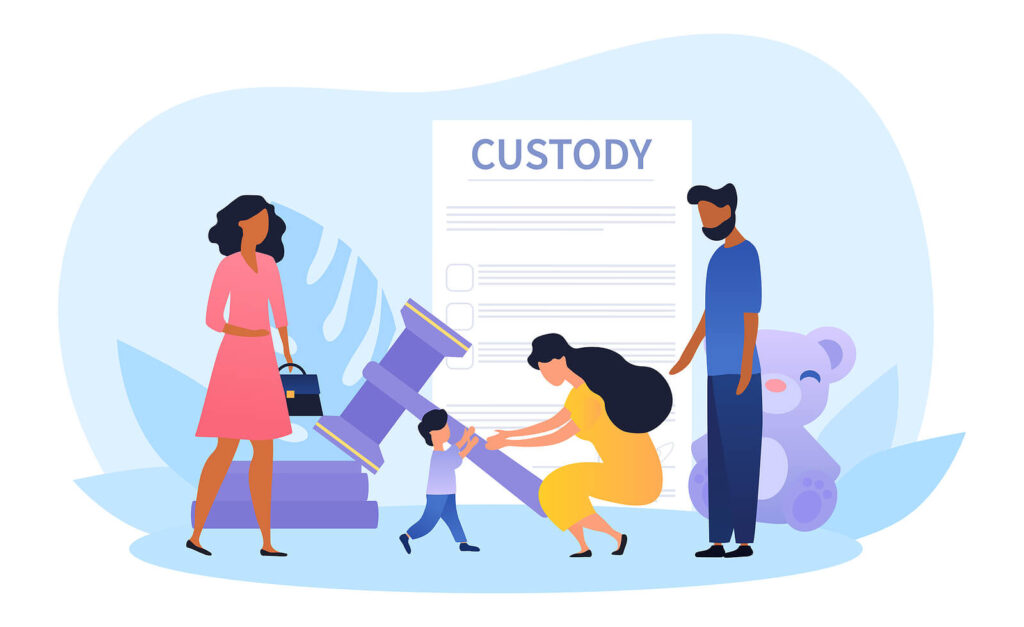Divorce can be a challenging and emotionally charged experience for everyone involved, but for children, it introduces significant changes to their daily lives. As parents work through custody arrangements and new family dynamics, one of the most important goals is to ensure children can thrive despite the upheaval. Striking a balance between custody arrangements and consistency in children’s routines plays a critical role in their ability to adjust to post-divorce life.
The Role of Custody Arrangements in Children’s Adjustment
When parents divorce, custody arrangements become one of the most impactful decisions for the children. Whether the parents choose joint custody, where both share time with the children or sole custody with one parent, the way in which custody is handled can significantly affect the child’s emotional and psychological well-being.
One common question is: How long does it take for a child to adjust to divorce? The answer varies based on a number of factors, including the child’s age, temperament, the quality of the parent-child relationship, and the overall nature of the divorce. Generally, children may take anywhere from six months to two years to fully adjust to a divorce, though some may continue to experience residual effects beyond this period.

For children, the initial period following a divorce is often marked by confusion, anxiety, and sometimes a sense of loss. Younger children, for example, may have difficulty understanding why their parents are no longer together, while older children and adolescents may internalize feelings of anger or blame. What is crucial during this adjustment phase is creating an environment where children feel safe, loved, and supported—regardless of the specific custody arrangement.
Here are a few tips to help children transition after divorce:
1. Consistency is Key
Consistency can be achieved in a number of ways:
-Consistent Routines: Keeping the same bedtime, meal times, and school schedules can help children feel a sense of normalcy. Even if they’re moving between two homes, having these routines in place ensures that they’re not experiencing frequent disruptions.
-Consistent Expectations: Both parents should work together to maintain similar rules, discipline strategies, and expectations. When children experience conflicting rules at each household, it can increase confusion and emotional turmoil. Unified parenting strategies help provide clear boundaries and structure.
2. Parents Conflicts
After a divorce parents can have a lot of grief, anger, or resentment. Often times decisions are made from a place of emotions vs. values. Many children seen for divorce therapy at WHCC adjust better when parents are cordial with one another. Children that witness arguments, parents bad-mouthing the other parent, parents ignoring one another in public, etc., struggle more than children whose parents get along.
How well parents work together post-divorce is one of the most significant determinants of a child’s adjustment. When parents are able to co-parent effectively, communicate openly, and avoid exposing children to conflict, children tend to adjust better. If your co-parent relationship feels overwhelming and conflictual and/or your child is impacted by it, WHCC can help create a co-parenting plan as well as a child therapy plan to decrease conflicts within the family system.
3. Parent-Child Relationship
The strength of the parent-child bond is crucial. If a child feels secure in their relationship with both parents, they are more likely to navigate the challenges of divorce successfully. Children need reassurance from both parents that they are loved, valued, and that the divorce is not their fault. Most children will need quality time with parents when arriving from the other home. WHCC can create specialized activities and games that parents can do with children when they get home for easier transitions.
4. Having Two Homes
Children need to feel as though they have two homes, not just one. They should not be bringing suitcases or bags back and forth and should only take personal items (stuffed animals, iPads, etc.) between their homes. Children also should not be made to take off clothing paid for by the other parent to bring back to the other home since children should be made to feel as if all clothing items belong to them.
5. Age and Developmental Stage
A child’s age plays a large role in how they process and adjust to divorce. Younger children may struggle with feelings of abandonment or fear of being left alone, while adolescents may experience anger or even relief, depending on the circumstances leading up to the divorce. Tailoring support based on developmental needs is crucial. Younger children often need more consistency with bedtime routines, naps, etc. between two homes, while older children can be more open about what is helpful in transitioning between two homes.

6. Parental Alienation
There are different types of parental alienation with one being unintentional alienation. Many parents unintentionally alienate due to high levels of anxiety, fear, or anger. For example a parent may rescue a child or overly nurture a child who is complaining about the other parent. Of course, children need validation; however, rescuing reinforces that the other parent is the villain which will alienate them. Other forms of alienation may be eye rolls when other parent is talked about, telling children not to tell the other parent hello when at public events, having a step-parent overly involved, not putting a parent’s name on medical forms, not allowing children to call the other parent when in their possession, etc.
7. Child Therapy
For some children, professional counseling or therapy may be beneficial in helping them process their emotions. However, if you are struggling with a high-conflict co-parent relationship, child therapy can sometimes cause more harm. For example, child therapists who are not trained in co-parenting can unintentionally only focus on one house leaving the other parent feeling pushed out of the therapy process. At WHCC we are mindful of both parents’ needs as well as the needs of the child, and we work with the entire family system without causing harm to the child.
How Parents Can Help Their Children Thrive
Parents play a central role in shaping how their children experience and adjust to divorce. While it may be challenging to co-parent in the midst of emotional pain, setting aside differences for the sake of the children is paramount. Here are a few ways parents can foster a supportive environment for their children:
– Prioritize Communication: Keep lines of communication open between both parents and the children. Encourage kids to express their feelings, and avoid putting them in a position where they feel like they need to choose sides.
– Reassure Children Frequently: Let children know that both parents will continue to be there for them. Reassurance helps combat feelings of anxiety and uncertainty.
– Avoid Conflict in Front of Children: Witnessing parental conflict is one of the most damaging experiences for children during a divorce. Parents should make every effort to resolve disputes privately and in a mature, respectful manner.
– Stay Involved: Each parent should stay actively involved in the child’s life. This includes attending school events, being present at extracurricular activities, and spending quality time together.
![]()
Closing Thoughts from a Child Therapist in Katy, TX
While divorce presents many challenges for children, they can still thrive when parents prioritize consistency and a healthy co-parenting relationship. Custody arrangements that balance the child’s needs with stability in their day-to-day life, coupled with emotional support, can ease the transition. By focusing on the well-being of the child, both during and after the divorce, parents can help create a stable foundation that enables their children to adjust and ultimately succeed.
Supporting Children Through Divorce
Navigating divorce and co-parenting is challenging, but you don’t have to go through it alone. At WHCC, we specialize in supporting families through the transition by creating tailored co-parenting plans and providing therapy that centers on your child’s emotional well-being. Let us help you create a balanced environment where your child can thrive despite the changes.
- Reach out to us here.
- Learn more about WHCC and the services we offer.
- Discover how we can support you in this time of change.
Other Services at WHCC
In addition to child therapy, WHCC offers a wide range of services to support the entire family. Our team provides teen therapy to help adolescents navigate emotional challenges, and adult therapy to address personal growth, mental health, and well-being. We also specialize in parent coaching, offering tailored strategies to support parents in fostering healthy relationships with their children. For couples, we provide marriage or relationship counseling to strengthen connections and improve communication. Our trauma therapy helps individuals heal from past experiences, while LENS neurofeedback offers a cutting-edge approach to managing anxiety, ADHD, and more.

